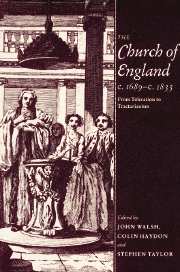Book contents
- Frontmatter
- Contents
- Preface
- List of Abbreviations
- 1 Introduction: The Church and Anglicanism in the ‘long’ eighteenth century
- Part I The pastoral work of the Church
- Part II Crisis and reform
- Part III Identities and perceptions
- 13 The eighteenth-century Church: a European view
- 14 Portrait of a High Church clerical dynasty in Georgian England: the Frewens and their world
- 15 ‘Papist traitors’ and ‘Presbyterian rogues’: religious identities in eighteenth-century Lancashire
- 16 Church parties in the pre-Tractarian Church of England 1750–1833: the ‘Orthodox’ – some problems of definition and identity
- Index
13 - The eighteenth-century Church: a European view
Published online by Cambridge University Press: 13 October 2009
- Frontmatter
- Contents
- Preface
- List of Abbreviations
- 1 Introduction: The Church and Anglicanism in the ‘long’ eighteenth century
- Part I The pastoral work of the Church
- Part II Crisis and reform
- Part III Identities and perceptions
- 13 The eighteenth-century Church: a European view
- 14 Portrait of a High Church clerical dynasty in Georgian England: the Frewens and their world
- 15 ‘Papist traitors’ and ‘Presbyterian rogues’: religious identities in eighteenth-century Lancashire
- 16 Church parties in the pre-Tractarian Church of England 1750–1833: the ‘Orthodox’ – some problems of definition and identity
- Index
Summary
My object in this essay is to remind us that, though one might never guess it from modern historical writing, there was still a Protestant world in the eighteenth century to which the Church of England belonged, to which it was acknowledged to belong and to which it regarded itself as belonging. There were of course Anglicans who specially prized features of their Church which they did not find in continental Protestant churches, Restoration High Churchmen who cherished the delusion that the Church of England was the very pattern of the primitive Church, as there are some at present who cherish the delusion that the Church of England is the very pattern of a putative coming Great Church. The mixture of coyness and downright hostility to the word Protestant which is now characteristic of Anglican, and increasingly of British, church opinion generally is hardly to be found. This is not very surprising in view of the fact that the political nation had had to turn first to a Dutch Reformed and then to a German Lutheran monarch and finally to a great deal of diplomacy, secular and ecclesiastical, to keep out the Catholic branches of the Stuart line. It is particularly worth examining the European standing of the Church of England, both in contemporary perception and in historical retrospect, because, if there is one period of Anglican history of which subsequent Anglicans have been ashamed, it is the eighteenth century.
- Type
- Chapter
- Information
- The Church of England c.1689–c.1833From Toleration to Tractarianism, pp. 285 - 298Publisher: Cambridge University PressPrint publication year: 1993
- 1
- Cited by



